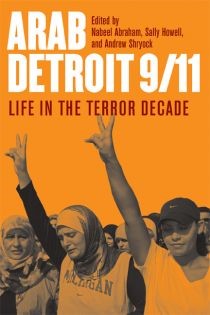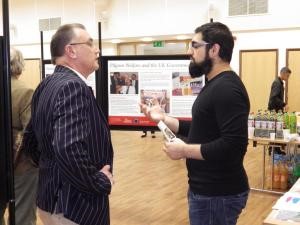Being Muslim in Bradford and Southeast Michigan: Exclusion and Visibility, Diversity and Cohesion

A few years ago I was fortunate to be invited to undertake a three-day lecture tour in the United States organised by the British Council in Washington as part of its “Our Shared Future” programme. A partnership with the Carnegie Corporation of New York, this programme aimed to improve the often fraught public conversation about Islam and Muslims in the West based upon inputs from academic research. My travels took me to Southeast Michigan and while I knew of the area’s longstanding association with the car industry and the Motown record label, it is a measure of the lack of trans-Atlantic scholarly exchange in my field that I was hitherto unaware of a significant American-Muslim community settled there.
Back in the UK I have conducted mainly ethnographic research among the Muslim communities established in northern England’s mill towns (see for example, Writing the City in British Asian Diasporas, Routledge 2014). It was for such reasons that the British Council first contacted me, suggesting that West Yorkshire and Southeast Michigan could prove an interesting comparison. Both former industrial powerhouses have been struggling to reinvent themselves in a post-industrial economy. Both also have large Muslim populations whose presence has transformed the public life and space of small, regional cities such as Bradford and Dearborn. In the current political climate, too, both have been the focus of state surveillance and targets for right-wing, anti-Muslim demonstrations.
My visit saw me meet with staff and students at Wayne State University in Detroit and the University of Michigan at Ann Arbour. I also visited the Arab American National Museum in Dearborn, which was founded after ‘9/11’ by a grassroots welfare organisation, the Arab Community Center for Economic and Social Services (ACCESS). I spoke, too, at an event co-hosted by the Institute for Social Policy Understanding (ISPU) which, again, was established post ‘9/11’, but this time by young, South Asian heritage American-Muslims with an interest in research. Both initiatives work locally and nationally in the US to dispel mainstream misconceptions about their communities.
My key concern during the tour was to gain an initial impression of how processes common across the Atlantic might be mapping out in ways that are both similar and different at national, regional and local scales. What follows are four brief reflections which have stayed with me since my tour. Together they underline the diversity of circumstances in which Muslim communities live in the West.
Firstly, in the last decade anti-Muslim sentiment has probably been more intense in the US than in the UK. However, while I was in Michigan the relatively muted initial response to the Boston marathon bombings in 2013 was being regarded as progress in this regard. Overall, the anti-Muslim lobby in the US to date has been more organized, better-funded and powerful. While such a constituency is not at all absent in Britain, it has been less clearly inserted into the mainstream of public life although the reach of social media and other forces is of course ever increasingly transnational.

Secondly, there is a greater visibility of Muslims more generally in the UK public sphere, in part because Muslims are the most significant ethno-religious minority, as they are across Western Europe. In the US, the Muslim population is roughly the same size as it is in the UK, despite the total population of the UK being around one-fifth of that in the US. Therefore, while Muslims in the UK remain underrepresented in many ways, they have made significant inroads into political parties at national and especially local levels, and find it easier to gain recognition than Muslims in the US who must compete (or better co-operate) with other larger minority constituencies. Nevertheless, in a period of austerity and ‘small state/big society’ given the global financial crisis, which in the UK follows a period in which government invested heavily in British Muslim civil society, the latter may have to learn from its US counterpart in cultivating more of a culture of philanthropy to finance community development.
Thirdly, Dearborn’s Arab population is religio-ethnically super-diverse and includes significant numbers of Arab American Christians, Shi’is just as much as Sunnis, as well as various ethno-national constituencies. As a provincial UK city, Bradford still represents quite a sharp contrast in this regard. Though divided along lines of kinship and Sunni denomination, its Pakistani Muslims represent a large majority of all ethnic minorities in the city. Nevertheless, in both locations, Muslim unity is a sensitive topic and organisations have to work extremely hard to avoid duplication of effort and sustain meaningful co-operation when working with wider society.

Dr McLoughlin in discussion at a recent research outreach event in Bradford
Finally, while a government policy discourse about the need for greater social cohesion in the UK has identified South Asian Muslims with close connections to ethno-national homelands as especially ‘problematic’ in this regard, it seems that such a discourse is less pronounced in the US. This may be in part because Bradford’s residentially clustered Pakistani population is increasing in size, residentially clustered and deprived. While Detroit itself has suffered from de-population overall and, despite a very mixed picture, its Muslim communities include significant numbers of socially mobile professionals, especially amongst suburbanised South Asian Americans. In both cities it is still constituencies with this profile that are most likely to possess the bridging and linking capital that views faith as a resource for civic engagement.
Dr Seán McLoughlin teaches on Islam and Muslims in Britain in the School of Philosophy, Religion and the History of Science at the University of Leeds, UK. He visited Southeast Michigan during the week of 15 April 2013.
